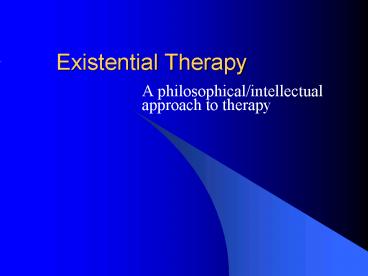Existential Therapy - PowerPoint PPT Presentation
1 / 12
Title:
Existential Therapy
Description:
Heavily influenced by existential philosophers (Kierkegaard, Nietzsche, Sartre, Buber, etc.) Viktor Frankl developed logotherapy, summed up in quote, 'He who has a ... – PowerPoint PPT presentation
Number of Views:1124
Avg rating:3.0/5.0
Title: Existential Therapy
1
Existential Therapy
- A philosophical/intellectual approach to therapy
2
Key Figures
- Heavily influenced by existential philosophers
(Kierkegaard, Nietzsche, Sartre, Buber, etc.) - Viktor Frankldeveloped logotherapy, summed up in
quote, He who has a why to live can bear with
almost any how. - Rollo Maytension between security of dependence
and the delights and pains of growth
Theory and Practice of Counseling and
Psychotherapy - Chapter 6
3
Key Figures
- James Bugentalhumanistic emphasis on the
integrity of each individual, help client examine
how they have answered lifes existential
questions, authentic living - Irvin Yalomfour ultimate human concerns death,
freedom, existential isolation and meaninglessness
4
Human Nature
- The existential movement stands for respect for
the person, for exploring new aspects of human
behavior, and for divergent methods of
understanding people. - The significance of our existence is never fixed
and once and for all rather we recreate
ourselves through our projects
5
Existential Therapy
- BASIC DIMENSIONS OF THE HUMAN CONDITION
- The capacity for self-awareness
- The tension between freedom responsibility
- The creation of an identity establishing
meaningful relationships - The search for meaning
- Accepting anxiety as a condition of living
- The awareness of death and nonbeing
6
The Capacity for Self-Awareness
- The greater our awareness, the greater our
possibilities for freedom - Awareness is realizing that
- We are finite - time is limited
- We have the potential, the choice, to act or not
to act - Meaning is not automatic - we must seek it
- We are subject to loneliness, meaninglessness,
emptiness, guilt, and isolation
Theory and Practice of Counseling and
Psychotherapy - Chapter 6 (2)
7
Identity and Relationship
- Identity is the courage to be We must trust
ourselves to search within and find our own
answers - Our great fear is that we will discover that
there is no core, no self - Relatedness At their best our relationships are
based on our desire for fulfillment, not our
deprivation - Relationships that spring from our sense of
deprivation are clinging, parasitic, and symbiotic
Theory and Practice of Counseling and
Psychotherapy - Chapter 6 (3)
8
The Search for Meaning
- Meaning like pleasure, meaning must be pursued
obliquely - Finding meaning in life is a by-product of a
commitment to creating, loving, and working - The will to meaning is our primary striving
- Life is not meaningful in itself the individual
must create and discover meaning
Theory and Practice of Counseling and
Psychotherapy - Chapter 6 (4)
9
Anxiety A Condition of Living
- Existential anxiety is normal - life cannot be
lived, nor can death be faced, without anxiety - Anxiety can be a stimulus for growth as we become
aware of and accept our freedom - We can blunt our anxiety by creating the illusion
that there is security in life - If we have the courage to face ourselves and life
we may be frightened, but we will be able to
change
Theory and Practice of Counseling and
Psychotherapy - Chapter 6 (5)
10
Awareness of Death and Nonbeing
- Death is a basic human condition that gives
significance to living - Death provides us a motivation to live our lives
fully and take opportunities for meaningful
activities - Yalom refers to death as a visitor in the
therapeutic process and should be explored
explicitly
11
Goals
- The basic goal of therapy is to enable the
individual to accept the awesome freedom and
responsibility to act.
12
Relationship Between Therapist and Client
- Therapy is a journey taken by therapist and
client - The person-to-person relationship is key
- The relationship demands that therapists be in
contact with their own phenomenological world - The core of the therapeutic relationship
- Respect and faith in the clients potential to
cope - Sharing reactions with genuine concern and empathy
Theory and Practice of Counseling and
Psychotherapy - Chapter 6 (6)

